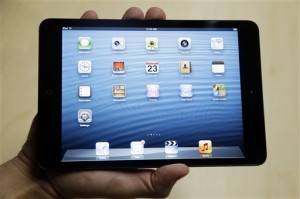SAN JOSE, California—Apple introduced the iPad mini on Tuesday, confident that a smaller version of its beloved tablet computer will trump lower-priced offerings by rivals Amazon, Google and Samsung.
“This is iPad mini,” Phil Schiller, Apple’s senior vice president for marketing, said as he displayed the new gadget at a company event in San Jose.
“This isn’t just a shrunken down iPad,” Schiller said. “It is an entirely new design.”
Chief executive Tim Cook coolly presided over the launch of what was considered his first Apple product not bearing the thumbprint of Apple’s late cofounder Steve Jobs, who derided small tablets as “DOA.”
Jobs publicly declared seven-inch tablets being fielded against iPad would be dead on arrival; that was unless they included sandpaper, “so that the user can sand down their fingers to around one quarter of the present size.”
Industry analysts noted that given his oft clever tactics, the derision could have been a ruse by Jobs to discourage competitors while Apple had a smaller version of the iPad on the drawing board.
The iPad mini’s touchscreen measures 7.9 inches diagonally compared to 9.7 inches on the original iPad.
‘Very cool’
A 16-gigabyte version of the iPad mini with Wi-Fi connectivity costs $329, while a 16GB model with both Wi-Fi and cellular capability costs $459.
The top-of-the-line 64GB iPad mini with Wi-Fi and cellular connectivity will sell for $659. Like later versions of the original iPad, the new Apple tablet also features rear- and front-facing cameras.
“That is very cool,” Cook said of the iPad mini.
People can begin preordering the iPad mini on Oct. 26 and Wi-Fi versions were set to begin shipping on Nov. 2 to about three dozen countries in Asia and Europe in addition to the United States.
Schiller said the iPad mini weighed 0.68 pounds, less than half the original, and is 7.2mm thick—thinner than a pencil.
Apple also unveiled a fourth generation of the original iPad for the same starting price of $499 for a 16GB model with Wi-Fi connectivity.
Cook said Apple sold over 100 million iPads in two and a half years.
He added that more than 275,000 applications were now available for the iPad in Apple’s App Store and that customers had downloaded a total of more than 35 billion apps.
Apple set the tablet computer market ablaze with the first iPad in early 2010 and stuck with its 9.7-inch screen while rivals introduced lower-price tablets with screens closer to seven inches.
More expensive
Amazon’s seven-inch Kindle Fire proved popular last year, and a new version was launched last month.
Meanwhile, a Google Nexus 7 powered by Android software has since joined the Samsung Galaxy in the seven-inch tablet market.
While the cheapest iPad mini costs $329, less than the original iPad, the device is still considerably more expensive than the seven-inch tablets from Amazon, Google and Samsung—which start at $199.
Independent technology analyst Jeff Kagan said the new, smaller iPad was a gamble for Apple in that it risked cutting into sales of the original iPad.
“Yes this will cannibalize some of the iPad, but pull the camera back and you can see how it will increase the size of the Apple customer base,” Kagan said.
“This will open up new segments of the market to Apple—segments that would like an Apple, but which prefer a smaller screen or a lower price tag.”
Apple shares ended the formal trading day down 3.26 percent to $615.25 but regained ground in after-market trades.
Some analysts believe the iPad mini was priced too high to fend off competition from Nexus 7 and Kindle tablets.
“Yes, $129 extra to be in the Apple ecosystem does seem pricey compared to the $200 alternatives,” said Forrester analyst Frank Gillett.
Slick Mac upgrades
“However, you are inside the Apple experience and have access to the 275,000 iPad apps,” Gillett continued.
“If those things are important to you, it is a no-brainer. If you are really focused on Amazon’s content, then the Amazon product is going to be more appealing,” he added.
Cook also introduced slick upgrades to Apple’s line of Macintosh computers, sales of which have outpaced the overall personal computer market for six years running.
Apple slimmed down its top-selling model, the 13-inch MacBook Pro, and gave it a “retina display” that boasts richer images than those on high-definition television sets. Starting price for the new MacBook Pro model was $1,699.
A new model iMac with the computing hardware built into its slim monitor promised to complement smartphones or tablets in modern lifestyles.
The new iMacs started at $1,299 with the first models available in November.
“What we see with this iMac is the early beginnings of redefining what we think about the personal computer in the world of mobile,” Gillett said.
“We will have a computer at home or work that picks up where we left off on our tablet, then puts it all back in when we walk away.” AFP
